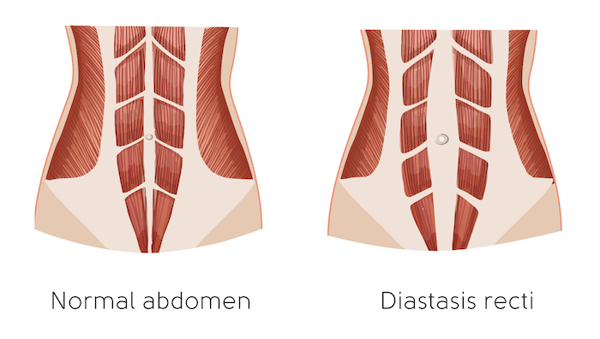Diastasis recti is a common condition post-pregnancy where the abdominal muscles (rectus abdominis) separate along the midline of the stomach, often appearing as a persistent bulge that doesn’t resolve after childbirth. While this separation typically heals naturally within 3–6 months postpartum, for some women, it can persist, causing functional and cosmetic concerns. Left untreated, it may increase the risk of back problems and other complications.
The good news? Diastasis recti is treatable with early diagnosis and professional care. But how does it happen, and what can you do to address it? Let’s explore.
What is diastasis recti?
Diastasis recti is the partial or complete separation of the rectus abdominis (commonly known as the “six-pack” muscles) along the linea alba, the connective tissue in the midline of the abdomen. This separation results in a weakened abdominal wall, allowing the organs to push outward and create a noticeable bulge.
During pregnancy, the growing uterus stretches the abdominal muscles and connective tissues to accommodate the baby. While this separation often resolves naturally postpartum, certain factors, such as multiple pregnancies, large babies, or excess amniotic fluid, can increase the risk of prolonged abdominal separation symptoms. Approximately 30% of women still experience diastasis recti one year postpartum.
How and why does diastasis recti happen?
Diastasis recti after pregnancy occurs when the abdominal muscles fail to re-oppose after childbirth. Several factors contribute to its development, including:
- Uterus expansion: During pregnancy, the uterus grows significantly, stretching the abdominal muscles.
- Multiple pregnancies: Repeated stretching weakens the abdominal wall, increasing the risk of separation.
- Polyhydramnios or large babies: Excess amniotic fluid or a larger baby places extra pressure on the abdominal muscles.
- Poor recovery: Lack of early intervention or improper exercises postpartum can delay or prevent muscle realignment.
For most women, muscle separation resolves naturally within 6 months, but persistent cases may require professional care.
Symptoms of dastasis recti (Abdominal separation symptoms)
The most common symptoms of diastasis recti include:
- Visible bulge: A vertical bulge along the midline of the abdomen, especially when straining or contracting the core.
- Core instability: Weak abdominal muscles that shift support to the lower back.
- Lower back pain: Resulting from increased strain on the lower back due to reduced core strength.
- Postural issues: Difficulty maintaining proper posture due to weakened core muscles.
- Digestive problems: Issues like bloating, constipation, or abdominal discomfort caused by a weakened abdominal wall.
Recognising these symptoms early is crucial for effective management and recovery.

How to tell if you have diastasis recti (Self-testing)
To find out if you have diastasis recti, you can follow the steps below:
- Lie on your back with your legs bent and your feet flat on the floor.
- Raise your shoulders off the floor slightly and look down at your stomach.
- Use the tips of your fingers to feel the muscles above and below your belly button. See how many fingers you can fit into the gap between your muscles.
- If you can fit two or more fingers into the gap, you may have diastasis recti.
You’re recommended to do this regularly after pregnancy, and if the gap does not start to narrow down after a few weeks, then you need to consult a doctor.
Treating diastasis recti
Mild cases of diastasis recti can be improved through physiotherapy and exercises. But more severe cases may require surgical repair.
Treatment by exercises
Certain exercises can help improve diastasis recti. You could try to tighten your tummy by doing some strengthening and stretching exercises to help your deep core muscles.
However, it’s important to remember that some exercises may do more harm than good. Avoid any strenuous activity that can cause your abdominal wall to bulge out, or strains the midlines of your abdominals. Specifically, avoid sit-ups, crunches and heavy lifting as they tend to worsen diastasis recti. If you’re unsure about what exercises are suitable, consult with your doctor.
Treatment by surgery
If you’ve been exercising for a while and there is still no improvement, or if you have moderate to severe diastasis recti (e.g.if you can fit 4 fingers between the muscle gap) it may be time to consider surgery.
Diastasis recti surgery is similar to a tummy tuck. Generally, it involves surgically bringing the separated muscles back together. Women post-pregnancy also commonly have excess abdominal skin; the skin is often re-draped and tightened during surgery.
The surgery involves excising the lower part of excess skin (including, if any, the caesarean scar and stretch marks from pregnancy). The surgery is performed under general anaesthesia and takes around 2 to 4 hours. Most patients can go home in 3 to 4 days.
Proper post-operative care can boost recovery and lessen recovery time. After surgery, most patients can gradually resume exercises to regain core strength.
As with most other plastic and reconstructive surgeries, diastasis recti surgery involves risks. Some common risks are blood loss, anaesthesia problems, infection, and other complications. You can discuss these with your doctor at length before proceeding.
Help at OT&P
At OT&P, we believe in the importance of giving our patients' awareness and control over their health at every stage. Whether you are looking to optimise your physicality and mobility or have been affected by injury, our physiotherapists at BodyWorX clinic will be able to tailor a solution for you. Book an appointment or call our registration desk to find out more.
 Central General Practice
Central General Practice
 Repulse Bay
Repulse Bay
 Clearwater Bay
Clearwater Bay
 BodyWorX Clinic
BodyWorX Clinic
 Central Specialist Clinic
Central Specialist Clinic
 MindWorX Clinic
MindWorX Clinic
 Partner Clinics
Partner Clinics
 Family Clinic
Family Clinic
 OT&P Annerley Midwives Clinic
OT&P Annerley Midwives Clinic



-1.png?length=500&name=%5BMKT%5DWebsite%20Blog%20Photo%20(16)-1.png)
-2.png?length=500&name=%5BMKT%5DWebsite%20Blog%20Photo%20(19)-2.png)
